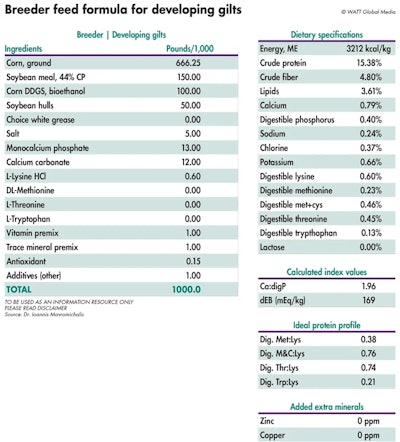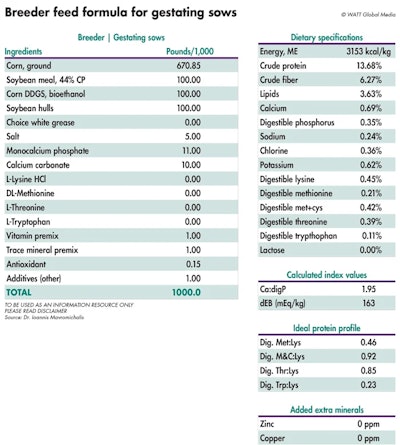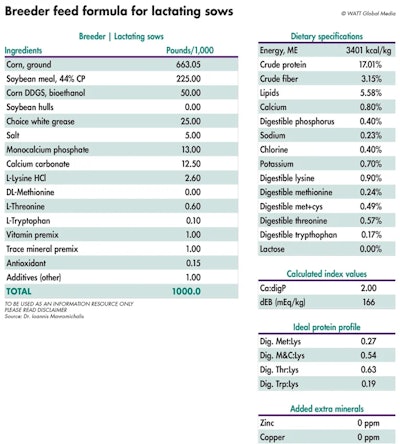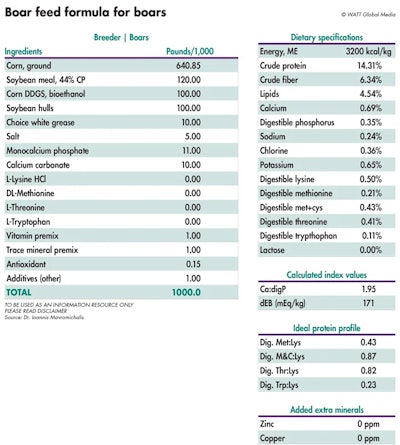Breeding pig formulations commonly used in US diets

Breeding pigs have received less attention in terms of research regarding their nutrient requirements compared with growing pigs. This is because breeding pigs require a greater time frame for research and a large number of animals per trial, both conditions that make such trials quite expensive. Thus, the nutrient levels presented in this set of formulas for breeding pigs are based more on practical experience, although they all meet minimum nutrient requirements set by NRC (U.S., 2012).

Downloadable PDF: Developing Glits
Developing gilts
In many cases, developing gilts are fed like growing-finishing pigs and, at about 100 kg, they are switched to a gestation feed to allow some fat deposition while restraining rapid muscle growth. As it happens, such approach results in overly fat gilts as they consume feed ad libitum, receiving more energy and less protein than what is optimal for them.
The formula presented here contains enough fiber to keep gilts satiated while they still receive enough energy, whereas adequate lean muscle development still occurs. An ideal feeding program for developing gilts destined for reproduction would start right after the nursery phase and continue until gilts are mated for their second gestation. In such a program, gilts would be fed on a restricted plane right after they reach 100 kg body weight. In most cases, however, this is rather difficult, and as such, high-fiber feeds are recommended to limit feed intake to acceptable levels.

Downloadable PDF: Gestating Sows
Gestating sows
During their first pregnancy (and lactation), gilts continue to develop. Thus, some producers allow for a special gestation feed for gestating gilts (the same applies for primiparous sows). However, this is often difficult to implement in most commercial farms, and the formula presented here can cover such special needs by allowing for a greater feed intake. In fact, this formula can be fed at levels between 2 and 3 kg per sow per day to allow for body condition and other genetic or management sources of variation.
It should be noted that this formula contains a rather generous amount of fiber in the form of soybean hulls. Some producers prefer to feed less fiber, or none at all, reverting to the use of a chemical laxative to avoid constipation, as they do not want to handle the larger volume of manure.
Gestating feeds are usually not fortified with feed-grade amino acids because (a) sows are fed only once or twice a day — and as such they are thought to utilize feed-grade amino acids less effectively, and (b) overall requirements are quite low and easily covered by a low inclusion level of soybean meal.

Lactating sows
This is the only breeding phase where a highly fortified feed and high feed intake are both essential for success with modern hyper-prolific genetics. As it happens, however, in many farms, lactating sows fail to consume enough feed to meet their daily needs. As such, they utilize body fat (and muscle in extreme cases) to produce enough milk yield for their litters. This is an ineffective way of utilizing feed nutrients and every effort should be made to increase sow nutrient ingestion during lactation. A nutrient-dense feed is one way to achieve this goal.
The formula presented here is meant for an average feed intake between 6 and 8 kilograms, depending on sow body condition and litter size. An old rule of thumb was to allow 2.5 kilograms of feed for sow maintenance needs, and then add 0.5 kilogram feed for each piglet nursed. Thus, a sow nursing 11 piglets would require 8 kilograms of feed per day, but more likely she would consume about 6 kg instead; a nutrient-dense feed thus aims to pack as many nutrients as possible in this limited amount of voluntary feed intake.

Downloadable PDF: Boar feed formula for Boars
Boars
This formula is intended for mature and sexually active boars. It resembles the gestation feed and in fact, in smaller operations that have boars, the gestation feed is often used instead. The boar formula contains slightly more energy and protein than the gestation one, but it is equally high in fiber to ensure satiety as these animals are also fed on a restricted plane of about 2 to 3 kilograms per head per day. When a separate boar feed is allowed, then such feed can contain certain vitamins, minerals and additives that enhance reproductive performance.
Feed ingredients
These formulas are based on corn and soybean meal but some allowance was made to include DDGS as before. Higher levels of DDGS are possible, but here we only wanted to indicate the widespread use of this ingredient and not find the limits of such usage in practice. In addition, soybean hulls are included because they are favored by most producers, not only because they are very palatable, but also because they are more widely available than wheat bran.
The latter is used extensively in Europe and any other areas that cultivate and process wheat for flour. Quite often, these high-fiber ingredients find their way to lactation feeds. This is counterproductive as fiber tends to cause early gut fill and thus restrict overall nutrient ingestion. Instead, a chemical laxative such as magnesium sulfate or potassium chloride should be used in lactation feeds.
Feed additives
Additives are not included here, again, and their inclusion levels of 1 kilogram per metric ton are more placeholders. The most commonly used additives are antioxidants to prevent lipid oxidation, phytase to replace phosphate salts, and yeast products that improve reproductive performance in several ways. Of course, vitamin and trace mineral premixes are always included.
In fact, certain vitamins and trace minerals can be supplemented above normal levels to aid lactating sows and boars. In summer (hot months) an additional array of additives can be added to help from heat stress. Such additives, include sodium bicarbonate, vitamin C, and betaine among the most widely used. In general, however, breeder feeds contain fewer additives than feeds for growing pigs.
Table of Contents
In 2020, WATT Global Media and Ioannis Mavromichalis, Ph.D. published a series of animal feed formulas as a general information resource material. These formulas are not complete, but the exclusions, such as additives and vitamin/mineral premix specifications, are either covered in other publications or will be published in the future as part of this library of feed formulas.
Layer feed formulations and analysis
The article acts as a guide to describe Mavromichalis’ approach to the development of the series and frames how to use the information found throughout.
General: How layer feed formulas for U.S. white and EU red layers were created
Each installment of the layer feed formula installment includes analysis and sample formulations for typical layer diets for both U.S. white and EU red hens during both the development and production phases of the life cycle. In total, there are 12 formulas.
- Feed formulations for white US layers in the development phase
- Feed formulations for US white layers in the production phase
- Feed formulations for EU red layers in the development phase
- Feed formulations for EU red layers in the production phase
Swine feed formulations and analysis
This article acts as a guide to describe Mavromichalis’ approach to the development of the series and frames how to use the information found throughout.
General information: How the swine feed formulations were created
Each swine feed formulation feature includes analysis of the defined diet and includes sample formulations for different points in a pig’s life cycle: nursery/young pigs, grower-finishing and breeding.
- Piglet feed formulations
- Common US grower-finishing pig feed formulations with corn, soybeans and DDGS
- Breeding pig feed formulation commonly used in US diets
Broiler feed formulations and analysis
This article acts as a guide to describe Mavromichalis’ approach to the development of the series and frames how to use the information found throughout.
General information: How the broiler feed formulas were created
Each separate broiler feed formulation feature includes analysis of the defined diet and includes sample formulations of rations at different points in the life cycle of the broiler chicken: starter, grower and finisher.
- Traditional US broiler feed formulations with corn, soybean meal and poultry meal with antibiotics
- All-vegetable US broiler feed formulations with corn and soybean meal without antibiotics
- Modern European broiler feed formulations with wheat, soybean meal, rapeseed meal & fish meal without antibiotics
DISCLAIMER: All information under the section of Animal Feed Formulations Library is provided only as an information resource. It is not to be used or relied upon for any academic, commercial, public, private or other purposes. This information is not intended to be education for students or any other professional and does not create a student-mentor relationship. This information is not intended to be consulting for private or public entities and persons and does not create a client-consultant relationship. This information should not be used as a substitute for professional advice. Please consult with your local nutritionist, extension professional, feed representative or specialist, veterinarian or animal science technician before making any nutrition related decisions or for guidance about any specific nutritional or other issue.
Ioannis Mavromichalis, Ph.D., WATT Global Media and their owners, affiliates and employees shall have no liability for any damages, loss, injury, financial or animal performance and results, or liability whatsoever suffered as a result of your reliance provided in this section, even after your consulting with your advisers.
Contacts:
For comments, questions or suggestions, please contact Ioannis Mavromichalis, [email protected], or Feed Strategy's editor Jackie Roembke, [email protected].